Nestled between the Arabian Peninsula and the Indian subcontinent, the Arabian Sea has played an incredibly important role in global history and trade. Its strategic location has long made it a focal point for navigation, commerce, and geopolitical interests, especially for the countries along its vast coastline.
The countries bordering the Arabian Sea are Yemen, Oman, Pakistan, Iran, India, and the Maldives. This post offers a closer look at each of these nations and the wider significance of the Arabian Sea.
First, we’ll look at an Arabian Sea Map that details the borders of every country it borders. Then we’ll take a closer look at the unique relationships each country has with the Arabian Sea.
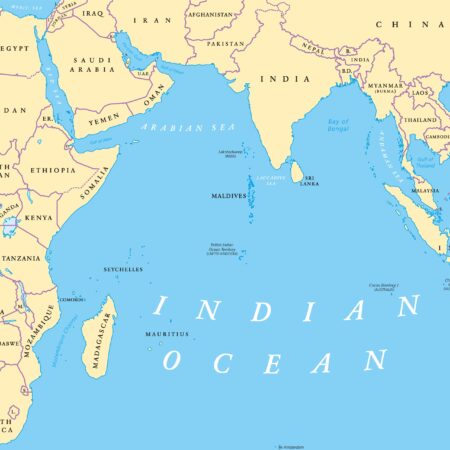
Countries in the Arabian Sea:
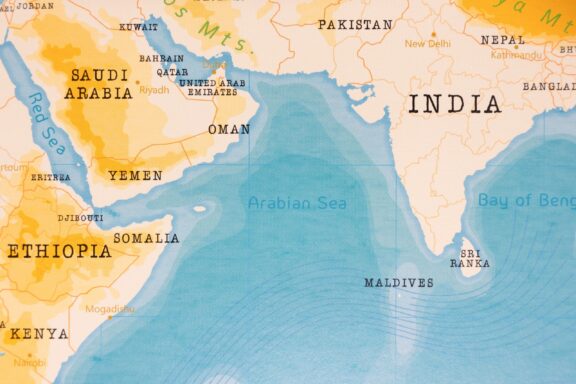
Yemen
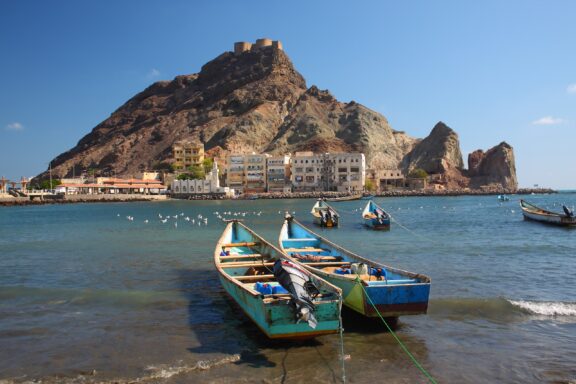
Located at the southeastern tip of the Arabian Peninsula, Yemen boasts a diverse landscape of mountains, plateaus, deserts, and coastal plains. The Arabian Sea meets Yemen at its southern coast, providing a maritime gateway and playing a significant role in the nation’s history and economy.
Yemen’s strategic position on the Arabian Sea, particularly near the Gulf of Aden, emphasizes its importance in global trade. The nation has several ports, with the Port of Aden being the most prominent, historically serving as a crucial stopover for ships traveling between Europe and Asia.
Yemen’s unique location also makes it the only country on the Red Sea that also borders the Arabian Sea. These seas have provided fishing opportunities for the people of Yemen for many years, and one of its ports was once famous around the world for its coffee.
Some of Yemen’s most fascinating geography is located on its island of Socotra, located in the Arabian Sea near the northeastern tip of Somalia. The island is one of the few places where guided tours are possible in Yemen, though it’s an experience best left to the most intrepid travelers.
Yemen’s untapped potential, especially in terms of tourism and maritime trade, remains constrained due to ongoing civil strife and political instability. The picturesque beaches and pristine waters of the Arabian Sea could eventually boost Yemen’s tourism sector, but the current political climate makes this unfeasible.
Oman
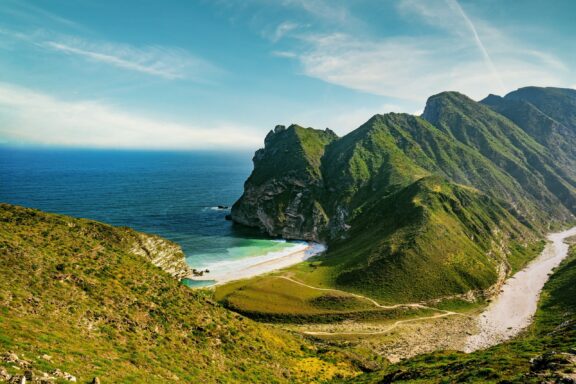
Oman, with its captivating landscapes that range from golden desert dunes to jagged mountain peaks, boasts an extensive coastline along the Arabian Sea that has been central to its history and development. The country, strategically located at the southeastern tip of the Arabian Peninsula, has long been a nexus of maritime trade, linking the East with the West.
Muscat, the capital of Oman, is a beautiful blend of the ancient and the modern. It stands as a testament to Oman’s rich maritime history, with its forts and palaces juxtaposed against modern architecture. The Port Sultan Qaboos in Muscat has historically been a hub for trade and commerce, fostering connections that have enriched Omani culture over the centuries.
To the south, in the Dhofar region, the coastal city of Salalah offers a different charm. Known for its annual monsoon, or Khareef season, Salalah transforms into a lush, green haven, drawing tourists from all over the Gulf and beyond. The ancient port of Al-Baleed in Salalah, now part of a UNESCO World Heritage site, stands as a reminder of Oman’s storied past in the Indian Ocean trade.
The Arabian Sea also provides Oman with rich marine biodiversity. Coastal towns like Mirbat and Duqm are not just centers for fishing but also gateways to pristine beaches and coral reefs.
Pakistan
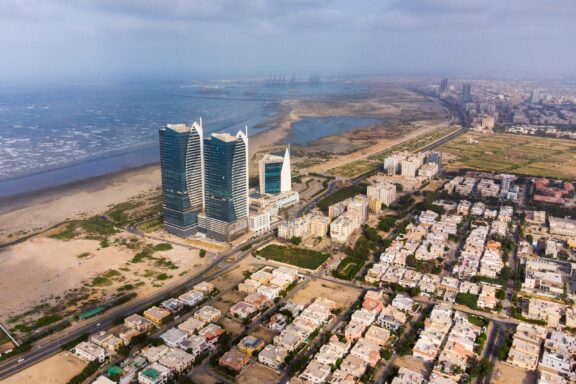
Pakistan’s Arabian Sea coastline, spanning approximately 1,046 km (650 mi), is a blend of bustling urban centers, tranquil beaches, and ecologically rich mangroves. While the coastal city of Karachi, often referred to as the ‘City of Lights,’ isn’t the political capital of Pakistan, it is the heart of the country’s economic activities.
With a population exceeding 15 million, Karachi is not just a bustling metropolis but also a historical testament to the region’s colonial past. The port of Karachi is among the largest in South Asia and serves as the primary gateway for Pakistan’s imports and exports.
Beyond the urban sprawl of Karachi lies Balochistan, with its rugged coastline and the emerging port city of Gwadar. Gwadar’s development has been a topic of significant interest, both regionally and globally, due to its strategic location and the potential to serve as a trade hub linking China to the Arabian Sea.
The coastal regions of Pakistan also house the Hingol National Park, the country’s largest national park, with its unique mud volcanoes and a variety of wildlife species. The Makran coast, with its cliffs and sandy beaches, offers a stark contrast to the urban centers and is a testament to Pakistan’s diverse landscape.
Iran
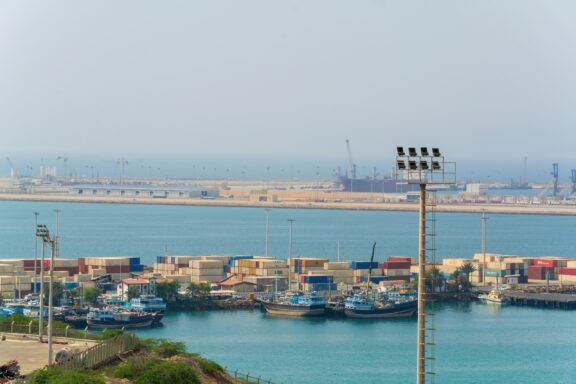
Iran is one of the oldest countries in the world, and while its territory along the Arabian Sea might not be as extensive as its Persian Gulf coastline, it is of great strategic importance. Sistan and Baluchestan, one of the 31 provinces of Iran, is situated along the Arabian Sea and holds significant potential for the country, though it is currently one of the least developed areas.
Chabahar port, located in the Sistan and Baluchestan province, is often termed as the ‘Golden Gate’ to the landlocked countries of Central Asia. With investments pouring in, especially from India, Chabahar is poised to become a major trade hub, bypassing the traditional Strait of Hormuz route. This port promises to reshape trade dynamics in the region, offering a direct trade route to Afghanistan and beyond.
The region’s cultural heritage is rich, with influences from Persians, Baloch, and other ethnicities. The coastal areas offer a blend of landscapes, from arid deserts to serene beaches, reflecting the diverse topography that characterizes Iran.
India
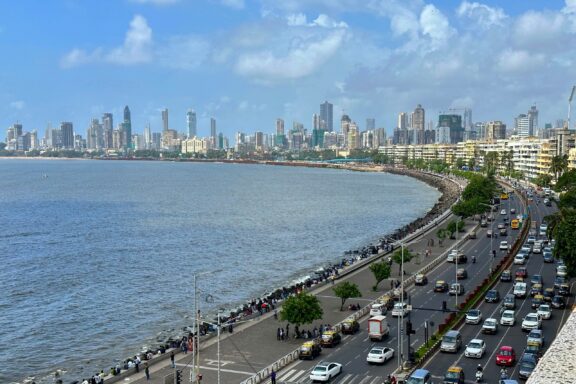
India’s coastline on the Arabian Sea is steeped in history and culture. The western coastline, which extends from the salty marshlands of Gujarat’s Rann of Kutch to the lush green backwaters of Kerala, is a blend of diverse cultures, languages, and traditions.
Mumbai, formerly known as Bombay, stands as the crown jewel of this coastline. As the financial capital of India, Mumbai’s ports handle a vast amount of the country’s maritime trade and are constantly striving to become more efficient.
The state of Goa, with its pristine beaches and Portuguese-influenced architecture, is a tourist paradise, drawing millions every year for its vibrant culture and scenic beauty. Kerala, known as “God’s Own Country,” boasts a unique network of backwaters, lagoons, and canals, making it a sought-after destination for tourists seeking tranquility.
Further north, the state of Gujarat, with its long coastline, has been at the forefront of maritime trade for centuries. The ancient port of Lothal, one of the world’s earliest, stands as a testament to India’s age-old maritime heritage.
Maldives
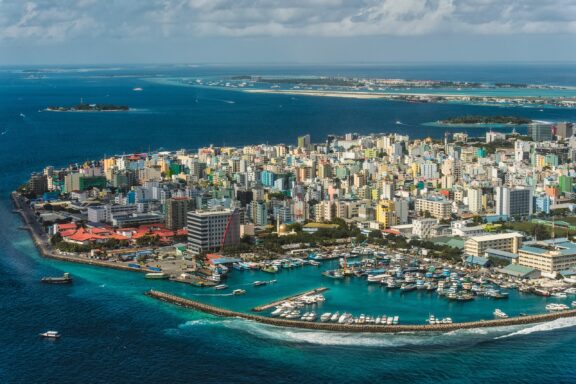
Located along the equator in the turquoise waters of the Arabian Sea, the Maldives is an archipelago of 26 atolls consisting of over 1,000 coral islands. This tropical paradise is renowned for its stunning coral reefs, clear waters, and luxury resorts, making it an irresistible tourist locale.
Beyond the luxury and the beaches, the Maldives holds a rich history. Due to its location, it served as a crucial stopover in the spice trade for centuries, with Arab, Indian, and East African traders frequenting its ports.
Seafarers from distant nations were also attracted to the islands for their abundance of pearls, spices, coconuts, dried fish, and cowry shells. Cowry shells were even an accepted form of currency until the late 19th century. The Maldivian culture is a unique blend of these influences, which are evident in its language, cuisine, and customs.
More About the Arabian Sea: FAQs
How did the Arabian Sea get its name?
The Arabian Sea has gone by several different names given to it by various cultures throughout history. It is called the Arabian Sea for the Arabian merchants who controlled much of the sea as well as its proximity to the Arabian Peninsula.
What is the importance of the Arabian Sea in global trade?
The Arabian Sea is a vital link between the West and the East, facilitating trade routes from the Middle East to India and Southeast Asia.
What kind of marine life is found in the Arabian Sea?
The Arabian Sea is home to a diverse range of marine life, from dolphins and whales to many species of fish and coral reefs.
What are the environmental challenges facing the Arabian Sea?
Overfishing, pollution from land-based sources, and the impact of climate change, especially on coral reefs, are significant concerns.
Which country has the longest coastline on the Arabian Sea?
India has the longest Arabian Sea coastline, measuring approximately 2,500 km (1,553 ft).
Who is the Queen of the Arabian Sea?
The port and city of Kochi, located in Southern India, was known as the Queen of the Arabian Sea for its role at the center of India’s spice trade.
What is the biggest island in the Arabian Sea?
The biggest island in the Arabian Sea is Socotra, which is part of a small island group belonging to Yemen.
Image Sources and Copyright Information
- Map of the Arabian Sea and Surrounding Regions: ® Peter Hermes Furian/Shutterstock
- Map Highlighting Countries Bordering the Arabian Sea: ® hyotographics/Shutterstock
- Traditional Boats in the Harbor of Aden, Yemen with a Fortified Hill in the Background: © Judith Lienert
- Scenic Coastal View of Al Mughsail in Salalah, Oman with Lush Greenery and Mountainous Landscape: © Emranovic/Shutterstock
- Aerial View of Karachi Cityscape with Coastal Skyline and Modern Buildings: © Aqib Yasin/Shutterstock
- Panoramic View of a Bustling Port in Chabahar, Iran: © Aref Barahuie
- Busy Coastal Road with Traffic Along the Mumbai Shoreline, India: © Paralllel3/Shutterstock
- Aerial View of a Densely Populated Island City with Colorful Buildings Surrounded by Turquoise Waters: © Chumash Maxim/Shutterstock